The Martha Graham Dance Company performs at City Center
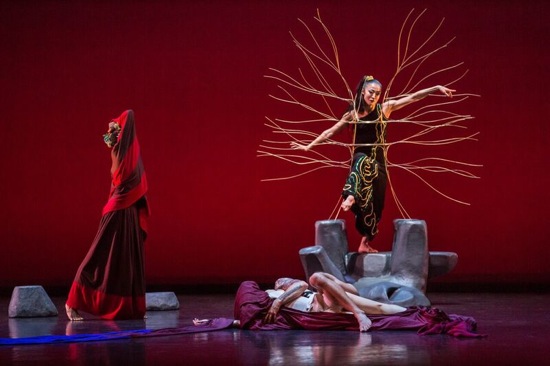
Martha Graham’s Cave of the Heart. L to R: Leslie Ann Willliams, Ben Schultz embracing Charlotte Landreau, and Peiju Chien-Pott. Photo: Brigid Pierce
Erick Hawkins once claimed that he never knew that Martha Graham, his partner, lover, and onetime wife was fifteen years older than he. She knew it, however (and habitually chopped several years off her age when documentation was needed). In 1946, a period when he and she were temporarily on the outs, she choreographed Cave of the Heart— not only a great work, but an artistic triumph over biography. Even as the character based on Medea, the role she created for herself devours the little red fabric snake of jealousy that she draws from her bosom, while shuddering along on her knees, so Graham chewed up and regurgitated the Greek legend of a sorceress who murdered Princess Glauce of Corinth with whom her lover, Jason, sought a propitious alliance.
Hardly a snappy opener, Cave of the Heart was the first work shown on one of the Martha Graham Dance Company’s programs during the group’s recent season at City Center. The dances that followed cringed slightly in its wake. With only four characters, Graham evokes startling images of passion and rage, presided over by the Chorus, a single female figure in a remarkable wide-sleeved, square-cut, red and brown-striped striped costume. The hero often balances on the trail of Isamu Noguchi’s sculptured rocks that lead toward the Chorus’s curious home (it has jokingly been described as the back half of an upended elephant’s body). The sorceress, lurking beneath the extraordinary metal “tree” that becomes in the end a glinting garment—the rage that scorches her—watches the two.
Lined up behind Medea and Jason, hardly visible at first, the little princess is “born” between their legs into a perilous trio. Later, Medea herself comes forward from under the Chorus’s voluminous robe, an initiate into vengeance. Jason is a strutting blockhead—as two-dimensional emotionally as he is (much of the time) physically. He totes his prospective queen around like a trophy or a ship’s figurehead. And when she rushes offstage trying to tear the poisoned crown Medea has set firmly on her head, he doesn’t even follow her. His grief only become evident when—in a stunning coup de theater—his nemesis enters, cloaked, her long train concealing and dragging the corpse of his bride behind her.
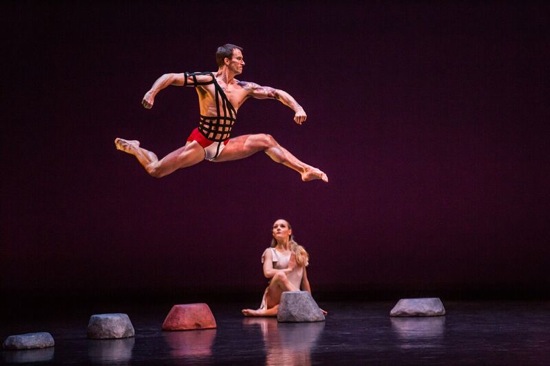
Ben Schultz as Jason in Cave of the Heart and Charlotte Landreau (seated) as his prospective bride. Photo: Brigid Pierce
There are other scorching images in Cave of the Heart, no less the last one, when Medea is caged and almost hanging within the golden tree. When she lies back over one of the gray sculptures, and the Chorus (who also embodies aspects of the nurse of Euripedes’ play) binds a red cord around her long, askew ponytail, you can see her as both a sacrificial creature and a warrior being readied for battle.
In the cast I saw, Ben Schultz performed the male role with the commanding, slightly pompous air it requires, and Charlotte Landreau as the Princess danced her solo to a light, playful passage in Samuel Barber’s score with charming naiveté. Leslie Andrea Williams conveyed both the Chorus’s majesty and her desperate attempts to avert the tragedy she foresees. Peiju Chien-Pott embodies Medea’s fury, lashing her body around, contracting it repeatedly, as if her guts were in turmoil. I think Chien-Pott may have learned the role in part from watching Takako Asakawa in the 1970s film of Cave of the Heart, and some of the head-cocking and sliding her eyes around seems almost at odds with her otherwise terrifically powerful performance. Perhaps Graham, directing the revival in her old age, decided that jealous fury had driven the heroine crazy. I continue to lament the addition of sequins to her costume and to the snake (!). Noguchi and sequins just don’t go well together.
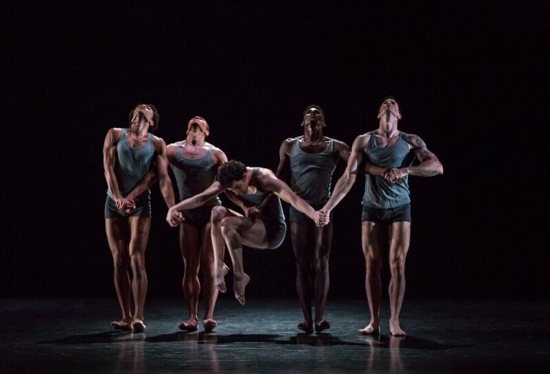
Nacho Duato’s Rust. (L to R): Abdiel Jacobsen, Ari Mayzick, Lorenzo Pagano, Lloyd Knight, and Ben Schultz. Photo by Brigid Pierce
Artistic Director Janet Eilber continues to commission choreographers who might expand the repertory with works that would be both venturesome and not clash too much with Graham’s own work. Having commissioned Nacho Duato’s Rust in 2013 for five of the company’s men (at City Center: Abdiel Jacobsen, Lloyd Knight, Ari Mayzick, Lorenzo Pagano, and Schultz), she countered its images of victimization, torture, and confinement with a kinky, slightly eerie new work for eight of the company’s women by Marie Chouinard, the adventurous Canadian choreographer. Rust has brilliantly sinister lighting and smoke effects by Brad Fields and is set primarily to Arvo Pårt’s De Profundis. Chouinard’s Inner Resources features a glowing red cyclorama and lighting (by Chouinard) that, in the end, explodes as if the light board had short-circuited. The music by Louis Dufort is at times fast and repetitive but also capable of static and sudden crashes.
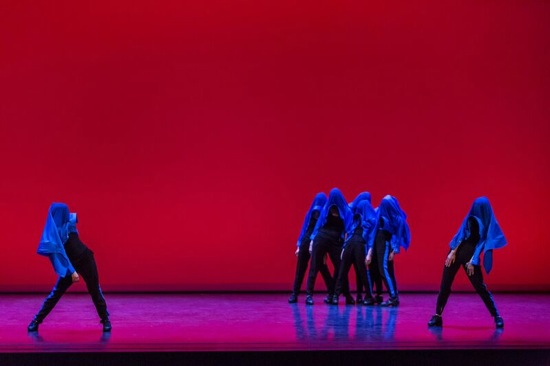
Marie Chouinard’s Inner Resources. Anne O’Donnell (L) and Xin Ying are observed by members of their cohort. Photo: Brigid Pierce
Unlike Rust, Chouinard’s work is eccentric, even gently comical, as well as troubling. The concept brings to mind Paul Taylor’s wonderful 1956 Three Epitaphs, in that the women first appear as strange creatures; you can’t tell one from the other as they stalk across the stage from one side to the other. On this journey, they wear loose-cut, bright blue shirts, whose collars are pulled up to cover their heads and obscure their faces. Beneath these, you glimpse their black-clad torsos, their legs in black pants, and the kind of black sneakers that permit rudimentary pointework. The women, bizarrely elegant, make me think of insect-like creatures picking their way along.
What are the rules governing this strange society? Set apart from the group, one of them shivers and shakes and drops to her knees. The others freeze or lean back, as if in aversion. Two have a spat, then more pair up and become combative. When the dancers push their coats back, they sport fake mustaches (!). Curiouser and curiouser, Alice would think, should these women-men appear in her Wonderland. The tallest of them, Konstantina Xintara, has a beard as well (the patriarch of this band of brothers?).
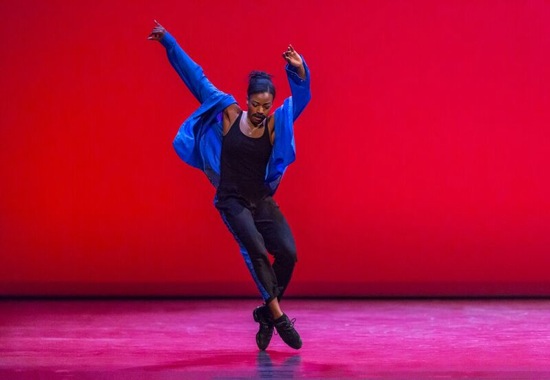
Leslie Andrea Williams, mustached, in Inner Resources. Photo: Brigid Pierce
The dancers (Laurel Dalley Smith, Lauren Newman, Anne O’Donnell, Anne Souder, Lauren Newman, Xin Ying, Leslie Andrea Williams, Xin Ying, Landreau, and Xintara) throw themselves into three-part counterpoint with deliberately clumsy vigor. They also look at us a lot. Challenging us? Hoping for our approval? Three of them grasp their partners’ thighs and hoist them off the floor; held up in a standing position, those lifted turn their heads to stare toward us. Various members of the tribe perform brief solos—gleeful, stubborn, grotesque—and some of the confrontations have the air of excited conversations in gesture. Chouinard has these gender-challenged creatures perform moves that your dance teacher probably told you never to do. They lurch toward the front of the stage, walking knock-kneed on the inside edges of their feet, or on the outside edges, dropping to their knees in ways that look as if they’re wrenching their joints. You feel very, very sorry for them, even though they clearly enjoy this new choreographic adventure and perform it with zest.
The blue shirts cover their heads again. Anonymity seems to be the rule. So perhaps it’s daring that, in the end, gazing at us, they shed them, drop them on the floor, and remove their shoes. And then there’s an explosion, and the red stage turns blue, then black.
What do you think, Martha, out there in eternity?
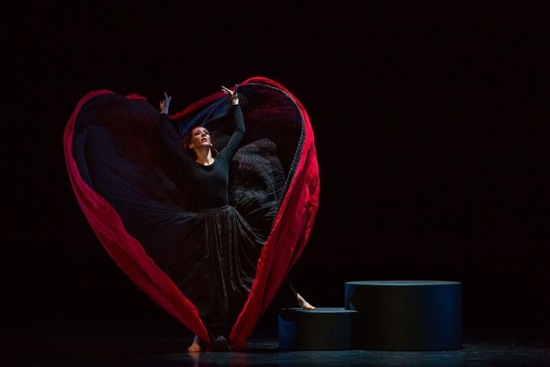
Blakeley White-McGuire as “Spectre of 1914” in Martha Graham’s Chronicle. Photo by Brigid Pierce
The program closed with the 1989 reconstruction of Graham’s 1936 Chronicle, portions of which were filmed early in its life. Wallingford Riegger’s music for it couldn’t apparently be found, so another Riegger composition was substituted (drawn, ironically, from the score he had written to accompany the 1935 New Dance by Graham’s early-days rival Doris Humphrey). Motivated by the Spanish Civil War and the involvement of Hitler and Mussolini, Graham titled her solo that opened the work “Spectre of 1914,” foretelling the world war to come. I’m not convinced the movement we see now is exactly what Graham did, but Blakely White McGuire splendidly invokes the spirit of it, rising on her platform to whip her extra-long, red-bordered skirt around, making it into a flag or putting some of it over her head to turn her into a mourning woman.
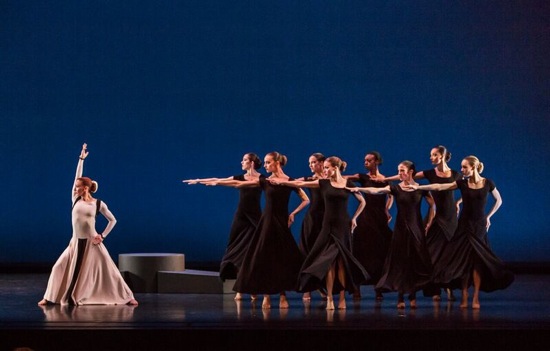
Blakeley White McGuire leads the women in “Call to Action” from Graham’s Chronicle. Photo: Brigid Pierce
Watching the displaced women of the “Steps in the Street” section jump over and over and over—traveling across the stage, without any steps between those explosions—knocks home the power of those early Graham dancers. Almost every move, every gesture is punched out; the women rebound from the floor as if it were a drum head (that’s how Graham told her students to think of it). When you consider the status and lives of many women in the United States in the 1930s, Graham’s warrior women must have shocked many of them.
Chouinard’s eccentric society is miles away from this one. That the dancers can bring both to life so whole-heartedly makes them heroes in my book.

Brave Deborah to write a review on a flight to Australia, and how grateful we all must be for the insights into Cave of the Heart. Those damned sequins gall me as well. Me, I wouldn’t even have attempted to write a review on such a trip; so glad Deborah did, would have liked to have seen the Chouinard, based on this review.
Just to clarify with regard to the music for Chronicle, there were originally five sections, of which three have been reconstructed. Of those, only the music for Steps in the Street could not be found, and so a contemporaneous piece by Riegger (originally written for Doris Humphrey) was substituted. For the other two sections, we do have at least some of the original music, which Stanley Sussman arranged to match the reconstructed dance.
I am grateful to Aaron Sherber for pointing this out. The music substituted for the missing section was drawn, I believe, from Doris Humphrey’s With My Red Fires, which premiered earlier in 1936.
Wasn’t the music substituted for “Steps in the Street” taken from the final section of Humphrey’s “New Dance”?
Thank you for this query. I will check the music for both that and “With My Red Fires.”
I’m not familiar with the linkages among the Humphrey works. The Riegger piece used for “Steps” is called “Finale from ‘New Dance'”. It looks like “New Dance” and “With My Red Fires” were both part of something called, somewhat confusingly, “New Dance Trilogy”. I have always understood that the Riegger was for “New Dance” itself, but I wouldn’t swear to it.
The music used for Steps in the Street was an orchestrated version of Riegger’s score for the Variations and Conclusion of New Dance. The Graham company acknowledged this in a program note by Ellen Graff, years after they used this music… It didn’t come from With My Red Fires.
I appreciate the comments that have accrued, and I’ve deleted my original statement that the Riegger music adapted for Steps in the Street wad drawn fro Doris Humphrey’s With My Red Fires and replaced that erroneous attribution to indicate that the Riegger music came from Humphrey’s New Dance (the Variations and Conclusion section), the third composition in her New Dance Trilogy, which was composed of Theatre Piece, With My Red Fires, and New Dance.